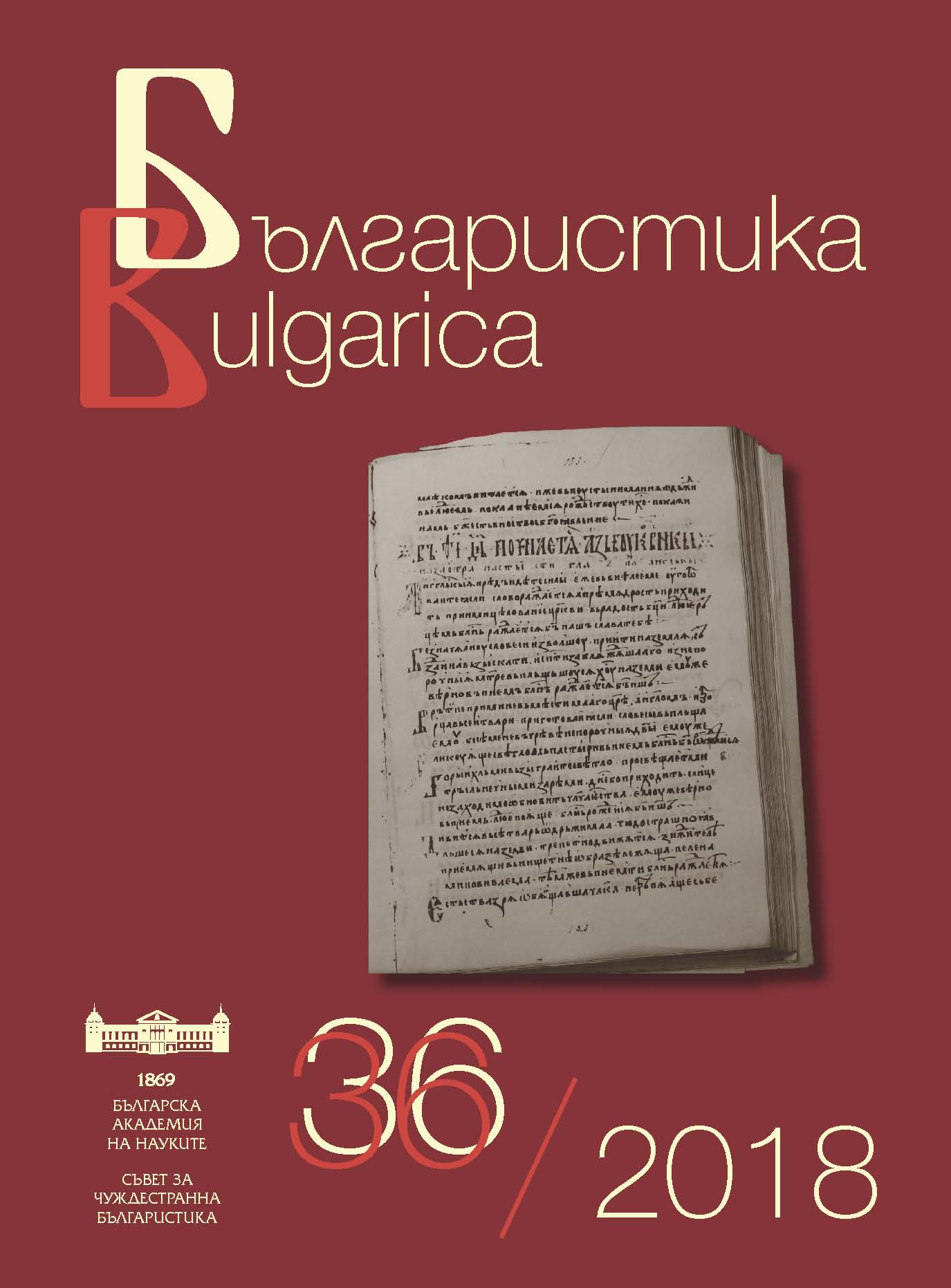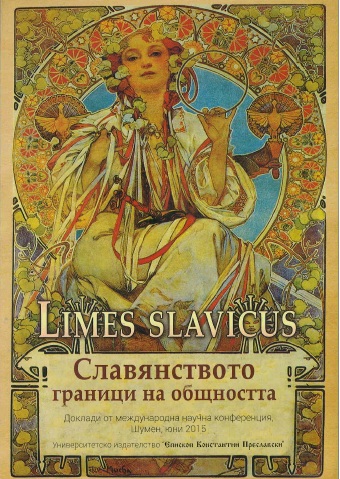
We kindly inform you that, as long as the subject affiliation of our 300.000+ articles is in progress, you might get unsufficient or no results on your third level or second level search. In this case, please broaden your search criteria.




The article is based on Michel Foucault's idea of the closeness between modern poetry and the ’discourse’ of insanity. The same idea is applied to the discussion of Maria Sudaeva's poetry collection Lozungi (Slogans).
More...
The article is dedicated to the hypothesis of the existence of an unknown hymnographer named Boris. There are a few texts under his signature. The article also highlights the possibility that Boris as the hymnographer might actually be Boris the First - Prince of Bulgaria.
More...
The article is an attempt at summing up the most recent discoveries in the field of Slavonic hymnography as well as finding the place and presenting the Golden Age in Medieval culture. It has become clear that Simeon I’s era was created by a large number of scholars, unknown so far. We could mention the names of Cyril and Methodius’s unfamiliar disciples, like Sisinii, Boyan, Eva, Prov, Leon Taonopisetz, Dragan, Erasmus; of unknown scholars from the same era- Stoyan, Ioan, Sebastian-Jean (it is possible that these could be two different translators), dean Jacob, Dox, Todor, Job and so on; of women-poets – the above-mentioned Eva, Tomiris, Anna, Evdokiya, from that same period. Along with the discovery of new names, new works of well-known authors were also discovered - significant number of works by Haum of Ohrid, unknown works by Clement, Cyril and Methodius, Ioan Exarch and so on. Connecting the different authors to the Preslav literary school, respectively to the Ohrid literary school is based on a specific characteristic of the Slavonic hymnography – co-authorship, the collaboration between two or more scholars. As the co-authors work at one and the same time, their acrosignatures guarantee the preciseness of the data (names and texts created by a certain author).
More...
The article comments on the influence of the Roman Pateric on agiography as a whole, and in particular on the Old-Bulgarian original agiography, whose most famous examples are Cyril’s Extensive Passional, Methodius’s Extensive Passional and later Ioan Rilski’s Nameless Passional. These observations justify the importance of the Roman Pateric in forming the life canon in principle and in a more concrete sense in acquiring and applying the agiographic traditions in the Old-Bulgarian passional texts. A proof of that is the common, to a different extent, topos which can be found between the Roman Pateric and the original agiographic Old-Bulgarian texts. The translation of the Roman Pateric is a part of the tradition which is the basis for the Old-Bulgarian scholars. What is different, however, is that the Roman Pateric formulates the theologian grounds both about the way of describing saints’ exploits and their proto-images as well as about the typology and the follow-up of the evangelical proto-image and the angiograph itself. This platform cannot be found in such a clear example in the other paterics. It turns out that the Roman Pateric is one of the important texts through which the Christian agiographic tradition in early middle-age Bulgaria was inherited.
More...
Old Bulgarian literary texts often use clichés that represent a generalized image of human wisdom; they express traditional values and attitudes and have a metaphorical nature, i.e. there is a great availability of different types of proverbs. The article uses specific examples to try to analyze the principles of functioning of the proverbs and the different ways they have entered into the literature.
More...
The subject of the article is the act of prayer in "The Prophet for Varlaam and Joasaph", focusing on shaping the ritual and the actions that accompany it. Here are also the moments in which the prayers are pronounced, by who and what are the reasons for the request to God.
More...
The book market in Bulgaria has been deluged with memoirs, memories, autobiographies and stories about the communist regime ever since 1989. A great number of the authors belong to the so called “nomenclature”, whose stories of the recent past fill the collective memory of a great part of the society, and this in practice makes this memory blocked by the usurped versions of the past because the narrative strategy in this case involves a focused selection or avoidance of the facts through euphemisms. On the other hand, the memories of the victims of communist regime are available – much less in number and in certain cases demonizing the system. Among the memories of the “executioners” and the memories of the victims abides the silence of “the little people” with their personal memories and individual stories of socialism, based on biographical data about the individual and the private path of socialization. Ilija Trojanow’s The world is big and salvation lurks around the corner, Dimiter Dineff’s Angel languages and Sybille Levitscharoff’s Apostoloff are novels, attempting to articulate this type of memories. Of special interest, in literary and oral personal stories, are the intersections between the "great history" of ideologies and the private versions of the experience in the individual stories. They provide information about the degree to which the public space has penetrated into the personal sphere, the everyday life of ordinary people, families, schools, the relationship between parents and children. They also show in what ways the narrative about the communist past nowadays influences the individual memory and the shared collective memory in the direction of idealizing, demonizing or marginalizing the past.
More...
The article outlines the advantages of an alternative classification of fairy folk tale types in folklore studies based on conceptual metaphor. The thesis that such a classification would have precedence over existing methods is defended, as it has the potential to combine the advantages of the two basic approaches to exploring the fairy folk tale – the etic and emic approach in folklore studies.
More...
This article presents a person’s progress from their home in search of their origin. Iliya Blaskov`s character from“Ill-Fated Krastinka“ chooses to recognize Rila Monastery as his home and this fact is indicative of recognising the monastery as a symbol of Bulgarian identity.
More...
The short stories of Elin Pelin have commanded the interest of many translators which is why they are rather well represented in the major European languages almost immediately after their publications in Bulgarian. This study focuses on the French language versions of the collection of short stories „Under the Monastery Vine” and their messages. The French translations of this cycle of stories give ample scope for diverse cultural transfers of knowledge about Bulgarian literature that shape the particularities of specific translator’s choices. They are indicative of the multiplicity of meanings as related to the historical context of the appearance of each translation and at the same time gesture towards research concepts the messages of which have undergone essential transformations thanks to the variations of the collection in the French language.
More...
What the four authors in the title of the present paper have in common, is positioning the dialogue between cultures in the topos of 'between', 'the border space'. Central to the plotline of the novels are the so-called 'no-places' (non-lieux, Nicht-Orte) (Auge), transtopoi (Foucault), such as airports, railway stations, harbours, planes, trains, ships, refugee camps, hotels, holiday resorts, parking lots, gas-stations, shopping malls. Such „open“ spaces are not only local markers; they often turn into main characters in this type of literary texts, which question the standard models of behaviour and thinking; change identities, transfer and bring together different cultural standards.
More...



